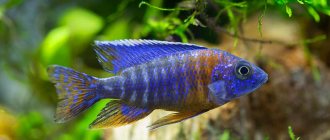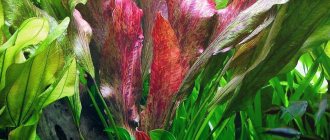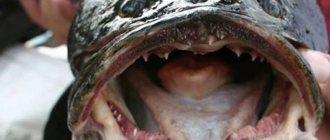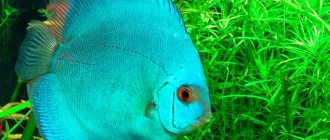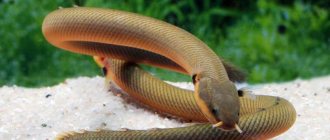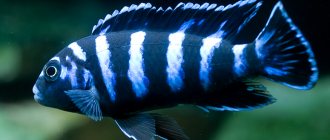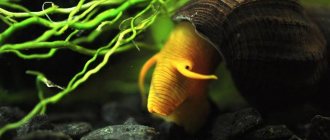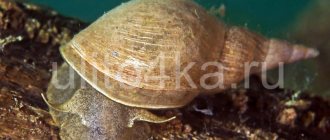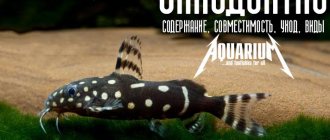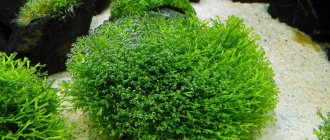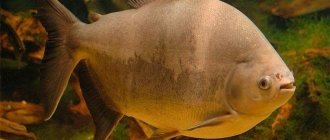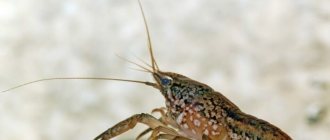Aulonocara (lat. Aulonocara sp.) is a freshwater fish belonging to the cichlid family. Lives in African Lake Malawi. Compared to the cichlids of the Mbuna group, Malawi are calmer, like to swim freely, and damage living plants less. There is no need to come up with special shelters for them.
Aulonocar females are gray, males are very bright. They come in yellow, gold, red, blue, blue, and also with various combinations of these colors. Because of their bright colors, these fish are called peacock cichlids.
Thanks to their bright colors, Aulonocaras have become popular aquarium fish. By crossing different species of aulonocara with each other, breeders created new bright species of fish. Depending on environmental conditions, the color intensity may vary. Aulonocaras become the brightest during spawning.
Appearance Features
Appearance of Aulonocara:
- Size . These are quite large fish; the size of an adult can vary from 9 cm to 20 cm.
- Body . It is characterized by an elongated, elongated shape with a high ridge characteristic of representatives of this species.
- Head . It is distinguished by its large size and peculiar, somewhat angular shape. At the same time, small depressions are visible to the naked eye in the head area.
- Fins . The dorsal fin is the longest and most prominent. Anal - has a rounded shape and is yellowish-gray in color. Dark vertical stripes run along the fin.
- Color. The colors can be very diverse. There are fish with scales of pinkish, turquoise, black tones with a metallic sheen that shimmers in the light. The fins have the brightest color. In most cases, they are colored blue, light blue or gold. The anal fin is decorated with yellow or orange dots randomly located along its surface.
Females differ from males in their smaller size, rounded dorsal fin and muted color. The scales of females are painted in the same colors as those of males, but they seem more faded and do not have a characteristic tint. An interesting fact is that in males, the coloring is fully formed only when they reach 1.5-2 years.
The average lifespan of aulonocara ranges from 8 to 15 years.
The age of the fish depends on the specific subspecies, as well as care and conditions of detention.
Description
It grows up to 13 cm, although males can be larger, up to 15 cm and more. It takes up to two years for a male to fully develop his coloration. However, they live quite a long time, up to 10 years.
Males are mostly bright yellow, with blue stripes along the body and a blue patch on the gill cover that extends to the lips. The fish has a sloping head with large eyes. Females are light gray or silver, with vertical brown stripes.
Since the fish quite easily crosses with other cichlids, there are now a lot of different color variations.
Conditions of detention
In order for the fish to maintain its bright color, live long and be healthy, it is important to create comfortable living conditions for it:
- Choosing an aquarium . Large and active fish require a fairly large amount of free space. Therefore, the minimum volume of the tank, designed to contain 4-6 individuals, must be at least 200 liters. If there are a larger number of fish or proximity to other aquarium inhabitants, the volume of the artificial reservoir should be 400 liters or more.
- Water parameters : temperature - from +22 to +26°C; hardness - from 10 to 77 dGh; acidity - from 15 to 25 units.
- Filtration must be powerful and constant. Aulonocara is sensitive to indicators of the chemical qualities of the aquatic environment, so it is important to avoid increasing ammonia levels and silting of the soil.
- Aeration is necessary for these fish, which require increased amounts of oxygen.
- Vegetation . In the natural environment, aulonocara lives in reservoirs where there are no green spaces. Therefore, the presence of vegetation in an artificial reservoir is also not necessary. If you want to use aquatic and surface crops to decorate your aquarium, it is important to choose plants with a strong root system that fish cannot damage.
- Lighting . The best option would be moderate and diffuse lighting, which will also highlight the natural beauty of these fish.
- Decorating an aquarium . When creating an aquarium design, you need to take care of the presence of secluded corners in it, which can be decorative castles, caves and grottoes, and various driftwood. However, experts do not advise overusing decorative elements, since aulonocaras require a lot of space to move freely in the aquatic environment.
- The soil . It is recommended to give preference to sandy soil.
- Replacing water . Aulonocaras need clean water. Therefore, the fluid in the aquarium must be replaced at least once a week by 25% of the total volume of water in the tank.
Caring for aulonocara is simple. The main thing is to take care of a spacious aquarium and keep it clean.
Habitat in nature
Aulonocara Bensch was first described in 1985. It is named baenschi in honor of Dr. Ulrich Bensch, founder of Tetra.
Endemic to Lake Malawi, they are found near Maleri Island, Chipoka, Nkohomo Reef near Benga. There are a total of 23 species of Aulonocara, although there are many subspecies.
It lives at a depth of 4-6 meters, but is also found at greater depths, often 10-16 meters. They can live both in caves and form large flocks. As a rule, each male has his own territory and shelter, and females form flocks.
They feed on various insects, which they search for and dig in the sandy bottom. To search for food, they have developed special sensitive pores on their jaws. They serve as a kind of sonar, helping to determine the noise from the entrenched larva.
As soon as the victim is discovered, she grabs it along with the sand. The sand is then spat out through the gills and the insect remains in the mouth.
Compatibility with other types
Aulonocaras have a calm and peaceful disposition, and therefore are compatible with most aquarium inhabitants.
Manifestations of aggression are possible only during the breeding season, but this problem can be solved by temporarily moving the fish to a separate spawning tank.
Excellent neighbors for Aulonocara will be:
- cichlids;
- blue dolphin;
- hummingbird;
- labidochromis yellow;
- aki blue;
- Copadichromis kadango.
It is not suitable to keep the peace-loving aulonocara in the same body of water with predatory, aggressive, overly large fish, such as:
- Haplochromis cornflower;
- some aggressive cichlid species;
- piranha;
- angelfish.
Also, you should not house aulonocara with overly active fish, since they are quite phlegmatic and periodically need peace and solitude.
Feeding
It is a known fact that the described individuals are unpretentious in food. Any food is suitable, both granulated and in the form of flakes. Individuals will not disdain “live” food, for example, cyclops, brine shrimp, and coretra. Bloodworms should be given to them in moderation. Aquarists recommend enriching and giving preference to foods containing a certain amount of carotenoids, as this will help improve the red shades on the fish.
Some cichlid breeders recommend making your own food. To make it at home, you will need the following ingredients:
All ingredients are ground and mixed. It is recommended to give the resulting mass a maximum of twice a day to avoid overfeeding aquatic pets. Feeding aulonocara involves alternating several types of food.
Breeding and reproduction
Aulonocara reproduce well naturally, even in an artificial reservoir. Moreover, this process does not even require special intervention from the aquarist. However, if you want to be guaranteed to get successful offspring, you should take care of creating optimal conditions for spawning.
Preparing for spawning . The size of the spawning tank should be about 200 liters per pair. It is imperative to decorate the tank with places for shelter and laying eggs. Grottoes, caves, crevices, and ceramic houses are perfect for these purposes.
A slight increase in temperature (up to +30°C) will stimulate and speed up the spawning process.
You can determine the readiness of fish to reproduce by observing your pets. During the mating season, males begin to show special activity, and the females' abdomen becomes rounded and increases in size.
Spawning . During spawning, males prepare places for laying eggs by making small holes in the sandy soil. After this, the mating dance itself begins, as a result of which the female lays from 15 to 80 eggs. Immediately after this process is completed, the female places the eggs and milt of the male in the oral cavity.
A unique feature of these fish is that the process of fertilization occurs in the mouth of the female. For females this is a very difficult period, because for 2 weeks during the formation of fry they have to refuse food.
Caring for offspring . The fry are born quite large and have an increased appetite. “Live dust”, brine shrimp, cyclops, and specialized food for fry are perfect for feeding babies. In the first months of life, when faced with potential danger, babies seek shelter in the mother’s mouth, from which they were born.
It is recommended to move the male to a common reservoir immediately after spawning, and the female after a month. Although some experts and experienced aquarists recommend doing this immediately after the fry appear. The fact is that, although aulonocaras are not prone to cannibalism, a female can accidentally swallow a baby trying to find shelter in her oral cavity.
Babies develop quickly and soon become completely independent. After a few months, they can safely be moved to a common artificial reservoir, with the exception of aquariums where predators live.
What to feed
Aulonocaras are predatory cichlids, so their diet should consist of 80% protein food. High-quality dry food, frozen shrimp, mussels, and brine shrimp are suitable for this. In addition to protein food, the aulonocar diet includes plant foods, for example dry food with spirulina. They are fed 1-2 times a day in small portions. Once a day you should give the fish a fasting day, that is, do not feed them at all.
Possible diseases
Aulonocaras have innate good health and strong immunity. However, if the conditions of detention are violated, and most importantly, if the water environment is polluted, there is a high probability of developing infectious diseases that require drug treatment prescribed by a veterinarian.
Aulonocara is a charming ornamental fish that attracts aquarists not only with its beauty, but also with its interesting habits, peaceful character, good compatibility with other inhabitants of the aquatic world and unpretentiousness in maintenance. Also, the fish are perfect even for beginner aquarists. A little attention, and these wonderful creatures will delight the eye for at least 8 years.
Fish diseases
The main cause of diseases lies in the conditions of detention; if they go beyond the acceptable range, then immunity is inevitably suppressed and the fish becomes susceptible to various infections that are inevitably present in the environment. If you first suspect that the fish is sick, the first thing you need to do is check the water parameters and the presence of dangerous concentrations of nitrogen cycle products. Restoring normal/appropriate conditions often promotes cure. However, in some cases it is impossible to do without drug treatment.
In general, the fish is well suited for both experienced aquarists and those who have just decided to try keeping African cichlids. They are easy to care for, easy to feed, they are quite unpretentious. In addition, they are distinguished by a calm disposition, which makes them desirable fish in general cichlids.
Video
Aulonocara photo
Most beautiful
As with all cichlids, the coloring of the female and male varies. At the same time, males are always brighter and more colorful. All females are silvery in color ranging from olive to brownish, with transverse dark stripes appearing. The fins are transparent.
Males come in four color variants: blue, ruby, yellow and multicolor. With any option, the shades of color smoothly transition into each other.
The head is always darker, and the back has an olive-greenish tint. When excited, dark stripes appear on the sides. Unpaired fins are blue with black spots. The fin on the back is long and has a light edge. The anal fin is pointed, with reddish spots. Interestingly, the closer to maturity, the brighter the color appears in male Aulonocara nyasa. The blue coloration of the male during the spawning period is the most beautiful. Although other color options look elegant.
Arrangement of the reservoir
Choosing a suitable aquarium is quite simple. The volume for two orchids should be at least 80 liters, and for a small group - at least 250.
Aquaparameters. Water indicators must be maintained within the following limits:
- temperature: 23-28 °C;
- acidity: 7.4-8.5 pH;
- hardness: 10-30 °dH.
It is important to monitor the water quality, it must be good. A filter, regular aeration and 15-20% changes every week will help with this.
Lighting can be anything.
Bottom arrangement. It is better to put quartz or river sand at the bottom.
The soil should not have sharp particles, since the fish dig it and sift it through their gills.
It is recommended to place large smooth stones, grottoes, and clay pots on it. You can build caves and rocks out of them, which the aulonokars will use as shelters. It is not advisable to decorate an aquarium with sea corals, as the fish may get injured by them.
A good decorative option can be obtained using sandstone, the light stones of which not only resemble grottoes, but also make the water hard, which African cichlids love.
Plants are not required, but if the owner decides to plant them, then they need to be properly strengthened in the ground, since aulonocaras can dig them up. Suitable:
- nymphea,
- anubias,
- cryptocoryne,
- hygrophila,
- limnophila,
- Vallisneria.
